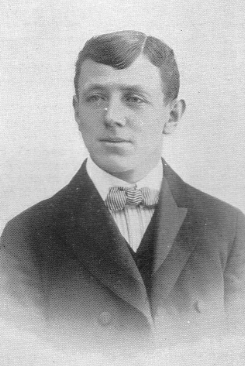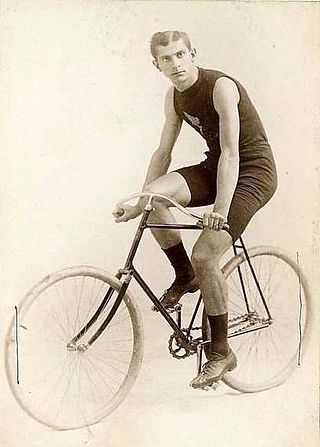
Track cycling is a bicycle racing sport usually held on specially built banked tracks or velodromes using purpose-designed track bicycles.

Maurice-François Garin was an Italian then French road bicycle racer best known for winning the inaugural Tour de France in 1903, and for being stripped of his title in the second Tour in 1904 along with eight others, for cheating. He was of Italian origin but adopted French nationality on 21 December 1901.

Paris–Roubaix is a one-day professional bicycle road race in northern France, starting north of Paris and finishing in Roubaix, at the border with Belgium. It is one of cycling's oldest races, and is one of the 'Monuments' or classics of the European calendar, and contributes points towards the UCI World Ranking. The most recent edition was held on 9 April 2023.

François Faber was a Luxembourgian racing cyclist. He was born in France. He was the first foreigner to win the Tour de France in 1909, and his record of winning 5 consecutive stages still stands. He died in World War I while fighting for France. Faber was known for his long solos; he is the only rider in Tour de France history to lead solo more than 1000 km.

Six-day cycling is a track cycling event that competes over six days. Six-day races started in Britain, spread to many regions of the world, were brought to their modern style in the United States and are now mainly a European event. Initially, individuals competed alone, the winner being the individual who completed the most laps. However, the format was changed to allow teams, one rider racing while the other rested. The 24-hours a day regime has also been relaxed, so that most six-day races involve six nights of racing, typically from 6pm to 2am, on indoor tracks (velodromes). Six-day events are annually hosted in London, Berlin, Ghent, Copenhagen, Hong Kong, Manchester, Melbourne and Brisbane.
The Bordeaux–Paris professional cycle race was one of Europe's classic cycle races, and one of the longest in the professional calendar, covering approximately 560 km (350 mi) – more than twice most single-day races. It started in northern Bordeaux in southwest France at 2am and finished in the capital Paris 14 hours later. The professional event was held from 1891 until 1988. It was held as an amateur event in 2014.

Oscar Egg was a Swiss track and road bicycle racer. He captured the world hour record three times before the First World War and won major road races and stages of the Tour de France and Giro d'Italia. He was also a noted developer of racing bicycles and bicycle components including lugs and derailleurs.

Albert Champion was a French track bicycle racer and later an industrialist who won the 1899 Paris–Roubaix. In 1905 he incorporated the Albert Champion Company in Boston to make porcelain spark plugs with his name on them. Three years later founded the Champion Ignition Company in Flint, Michigan. In 1922 he changed the name to AC Spark Plug Company, after his initials, to settle out of court with his original partners in the Albert Champion Company. The company is now known as ACDelco and is owned by General Motors.

Hippolyte Aucouturier was a French professional road bicycle racer. Aucouturier, a professional between 1900 and 1908, won two stages at the first Tour de France in 1903 and won three stages and finished second in the 1905 Tour de France. He also won Paris–Roubaix twice, in 1903 and 1904. His elder brother Francois was also a racing cyclist.

Jimmy Michael was a Welsh world cycling champion and one of the top riders in the sport for several years.

Maurice Brocco was a French professional road bicycle racer between 1906 and 1927. He was born into a family of Swiss-Italian immigrants. In 1911 he won a stage in the Tour de France. He participated six times in the Tour de France, but finished the race only once. In his later career he was successful in six-day races.

Arthur Augustus Zimmerman was one of the world's great cycling sprint riders and winner of the first world championship in 1893. His prizes as an amateur were a consideration in the establishment of the International Cycling Association (ICA).

Alf Goullet was an Australian cyclist who won more than 400 races on three continents, including 15 six-day races. He set world records from two-thirds of a mile to 50 miles, and the record for the distance ridden in a six-day race.
Charles Frédérick Barden (1874–1962) was a British cyclist. He placed second in the UCI Track Cycling World Championships men's sprint in 1896 and 1897. He held the English cycling title among other records. He was accused of dangerous riding among his colleagues. His career was ruined after the death of a fellow rider allegedly due to his negligence.
The Newark Velodrome was a bicycle track located on South Orange Avenue in Newark, New Jersey. It measured six laps to the mile, or 293 yards per lap. The track was built in 1907. The Newark Tornadoes of the National Football League also played several "home" games on the track's grassy infield, during the 1930 season, while the other "home" games were played at Newark Schools Stadium.

Motor-paced racing and motor-paced cycling refer to cycling behind a pacer in a car or more usually on a motorcycle. The cyclist follows as close as they can to benefit from the slipstream of their pacer. The first paced races were behind other cyclists, sometimes as many as five riders on the same tandem. Bordeaux-Paris and record attempts have been ridden behind cars. More usually races or training are behind motorcycles.
Speedwell was a brand of bicycle manufactured by Bennett & Wood, a firm established by Charles W. Bennett and Charles R. Wood in 1882 in Sydney. As motorcars and motorcycles became available Bennett and Wood entered the motor trade. They built and sold the Speedwell bicycle and the Speedwell and Acme motorcycles. The Speedwell motorcycle was built in the early 1900s.
The Six Days of New York was a former six-day cycling event, held in New York City, in Madison Square Garden's velodrome. Between 1899 and 1961, a total of 73 editions were held, sometimes three per year. Only the Six Days of Berlin and the Six Days of Ghent had more runnings. Australian Alfred Goullet and Italian Franco Giorgetti hold the record with eight wins each.

6 Day Bike Rider is a 1934 American comedy film directed by Lloyd Bacon, written by Earl Baldwin, and starring Joe E. Brown, Maxine Doyle, Frank McHugh, Gordon Westcott, Arthur Aylesworth and Lottie Williams. The film's production lasted for 11 days, starting on July 9, 1934. A multi-bicyclist collision happened during close-up filming. Reggie McNamara, who was known as the "Iron Man" due to his 108 six-day bicycle races, had his film debut as one of the racers. It was released by Warner Bros. on October 20, 1934.
Archie McEachern was a Canadian track cyclist. He was the Canadian National Champion of middle-distance races and was also the first Canadian to win the New York Madison Square Garden Six-Day Bicycle Race, in 1901. In 1902 he broke the world's indoor bicycle record for 5 miles in a motor paced race.














